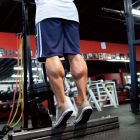 The question usually comes up: Is there a place in a strength program for higher reps? The answer is, absolutely. I use them in all of my routines, just not the beginning. The reason I don’t have my athletes start with higher reps is that I want their form to be honed to perfection. I also want them to develop a sound strength base before I insert higher reps.
The question usually comes up: Is there a place in a strength program for higher reps? The answer is, absolutely. I use them in all of my routines, just not the beginning. The reason I don’t have my athletes start with higher reps is that I want their form to be honed to perfection. I also want them to develop a sound strength base before I insert higher reps.
I usually incorporate higher reps via back-off sets, but, as I said, not until trainees have a solid foundation and do all the exercises correctly. Then 10s are fine—as are 12s, 15s and 20s. Higher-rep sets are most useful for improving the total workload, which is one of the keys to becoming considerably stronger.
I also like them for auxiliary movements—as soon as athletes are recovering sufficiently from the work done on the primary lifts. In the event I’m not sure if someone is recovering fully, I wait another few weeks because it is often the exercises for the smaller groups that get people in trouble in terms of overtraining. Nearly every male athlete wants bigger arms and will spend far too much time and energy working his biceps and triceps if he isn’t supervised.
Also, in many instances I have seen athletes use the same set-and-rep formula for their arms that they use for their legs and back—something close to five sets of five. Here’s something I learned on my own soon after I began training with weights: Once you’ve worked the smaller groups thoroughly, you cannot work them again with lower reps—and you have to work the primary exercises that involve the larger groups before you do any specific exercise for arms. I tried it both ways, and it only took a couple of sessions for me to determine that big muscles, then small muscles is the way to go, not the other way around.
The point is that once you’ve hit the tendons and ligaments of any muscle, you cannot come back in that same session and attack them in the same manner again. It’s just too much. What you can do, however, is work the muscle directly, without involving the attachments to any great degree, by using higher reps on the ancillary movements. So after a tedious session on the flat bench or incline, you can still do straight-arm pullovers or triceps pushdowns and derive the desired results.
If you choose higher reps on specific exercises for triceps or other ancilliary muscles, use the 40-rep rule—two sets of 20. That works well for any type of curls, laterals, front raises, dumbbell incline presses and the various leg machines: adductor, leg curl, leg extension.
The one exception to the rule is calf work. I believe that you have to hammer and abuse the calves in order to make them stronger—three sets of 30. If the equipment is available, I have athletes alternate standing calf raises and seated every other time they work lower legs.
I use a different set-and-rep formula for high-skill exercises, such as the Olympic lifts, but I’ll cover that next month.
Editor’s note: Bill Starr was a strength and conditioning coach at Johns Hopkins University from 1989 to 2000. He’s the author of The Strongest Shall Survive—Strength Training for Football, which is available for $20 plus shipping from Home Gym Warehouse. Call (800) 447-0008, or visit www.Home-Gym.com.




















You must be logged in to post a comment Login